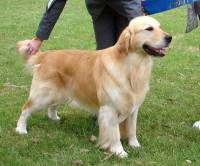Golden Retrievers
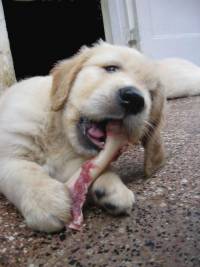 Golden Retriever pup
Golden Retriever pup
The Golden Retriever is one of our most popular breeds. His medium size, his soft, kindly expression together with his loving, biddable temperament makes him a popular family pet who meets the demands of modern society.
History of the Golden Retriever
 Tweed River Retriever
Tweed River Retriever
In Scotland, Lord Tweedmouth kept a Stud Book from 1835 which documents the early development of the Golden Retriever. Beginning by using a yellow Wavy (or Flat) Coated Retriever and a Tweed Water Retriever, the Earl of Ilchester, one of Lord Tweedmouth's descendants, methodically continued line-bred these dogs at the Guisachan Estate until 1890[2].
Additionally, Mrs Charlesworth, who formed the first Golden Retriever Club in England in 1911, states that Lord Tweedmouth (then Sir Dudley Majoribanks) obtained his first Golden or Russian (as they were then called) Retrievers when he saw a performing circus at Brighton. He was so impressed by their intelligence, he bought the whole Troupe of 8 and took them back with him to Scotland.
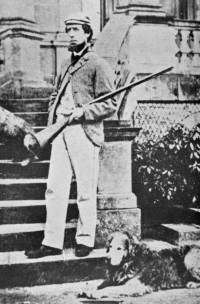 Keeper with Golden at Guisachan 1903
Keeper with Golden at Guisachan 1903
As there appears to be no detailed physical descriptions of the dogs named in Lord Tweedmouth's Stud Book, whether both these above theories are fact, or whether both theories went hand in hand, remains undocumented. But certainly in 1920 the original records which began with Lord Tweedmouth's dogs at the Guisachan Estate in 1835, were accepted by the Kennel Club (UK).
The Golden Retriever becomes a Pure Breed
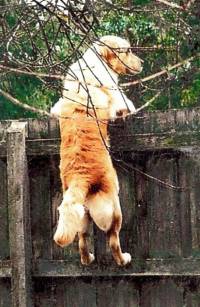 Golden Retriever
Golden Retriever
Before 1920 when Lord Tweedmouth's Stud Book was accepted, the Kennel Club (UK) classified Golden Retrievers as yellow coloured Flat Coated Retrievers. By the time Mrs Charlesworth founded the first Golden Retriever Club in 1911, this new breed was rising in popularity both in Field Trials and in shows. For example in 1909, only 8 Goldens were entered at the famous Crufts Dog Show. But by 1949, the entries in the Kennel Club Stud Book (listed by winning at Shows or Field Trials) had reached 198.[8]
Commencing with the solid foundation of records being kept continuously for almost 200 years, the Golden Retriever's enormous popularity is due in no small part to his docile and loving temperament resulting from so many decades of dedicated breeding.
History of Golden Retrievers in Australia
In Australia, although there are some reports of Golden Retrievers being brought here for field work earlier, documented proof of the establishment of the Golden Retriever was not until 1937 when Miss Grice of Mount Macedon in Victoria brought 'Grakle of Tone' from the UK. Several imports followed establishing her Rahween prefix. After World War Two the popularity of the Golden Retriever grew with many new enthusiasts emerging.
 Golden Litter from Artificial Insemination 1979
Golden Litter from Artificial Insemination 1979
In particular, history for the entire dog world was made in 1975 when English frozen semen was brought out here from the big winning English Champion Cambrose Cabus Christopher. Firstly Mrs Hope Phillipson from Queensland produced a litter of four. Then in 1979 after the death of the sire, Fred and Beryl Hession from New South Wales produced a litter of six (pictured), three of which became Champions[5c].
The technique of using frozen semen not only made a solid contribution to Golden Retrievers in Australia, but it also gave impetus for a new direction for our dog world by proving that the best dogs and bloodlines anywhere in the world could be made available to us.
Comparison between the Golden, Flat Coat and Curly Coated Retrievers
A convenient way to study the similarities and differences between these three Retrievers, is by a the comparison table below:
| Golden Retriever | Flat Coated Retriever | Curly Coated Retriever | |
|---|---|---|---|
|
|
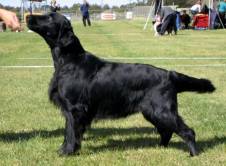 Flat coated Retriever Flat coated Retriever |
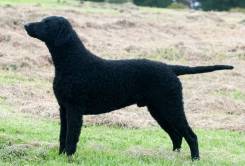 Curly Coated Retriever Curly Coated Retriever |
|
| General Appearance | Symmetrical powerful but well balanced cream or gold dog with a kindly expression | Medium sized black or liver elegant dog showing power without lumber and raciness without being weedy. | The tallest of all the retrievers, an upstanding, strong black or liver dog with a distinctive curly coat |
| Size | Height: Dogs 56-61 cms (22-24 ins) Bitches 51-56 cms (20-22ins) | Height: Dogs 58-61 cms (23-24 ins) Bitches 56-58cms (22-23 ins) Weight: Dogs 27-38 kg (60-80 lbs) Bitches 25-32 kg (55-70 lbs) | Height: Dogs 69 cms (27 ins) Bitches 64 cms (25 ins) |
| Colour
|
From the palest cream to the deepest yellow is equally acceptable as long as it is neither red nor mahogany. | Black or liver | Black or liver |
| Coat | Double coated with a thick water resistant undercoat and a flat or way top coat without curl, giving the coat a somewhat harsh feel. The feathering coat sometimes needs trimming which is acceptable. | The coat should be as flat as possible and although dense, should never be curly. His elegant outline is completed by his medium textured good quality coat and the feathering behind his legs and on the tail. | The body, neck and tail should never have any thin or bald patches. Instead the dog is completely covered in small tight-knit screw astrakhan type water-resistant curls that feel oily and crisp. |
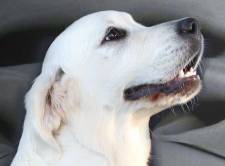 Golden Retriever Golden Retriever |
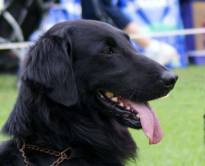 Flat Coated Retriever Flat Coated Retriever |
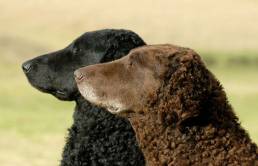 Curly Coated Retrievers Curly Coated Retrievers |
|
| Head | Without being coarse, the skull is broad and slightly rounded, and the very strong, wide and deep muzzle should not have too much flew. The length of the muzzle should equal that of the skull and the nose should be black. | The skull is long and looks moulded with a strong muzzle the same length as the skull. This head should be sufficiently strong to be capable of carrying a hare. The large nose should have open nostrils. | The head is wedge-shaped when viewed from either the side or the front. The skull and muzzle are of equal length with parallel head planes. The lips are tight and the nose black or liver depending on the coat colour. |
| Stop | Well defined | Slight | Slight |
| Eyes | Size to balance the head, set wide apart to give a soft, kindly expression, dark brown with tight dark rims | Medium sized but not obliquely set, dark brown or hazel with an intelligent expression | Large but not prominent, oval in shape and obliquely set. Dark brown in blacks but in livers colour to blend with coat. |
| Ears | Moderate size, set on approximately level with the eyes | Small and set on close to the head | Rather small and set on slightly above the level of the eye |
| Mouth | Normal scissors bite | Normal Scissors bite | Normal scissors bite |
| Neck | Of sufficient length to balance the body and clean (without dewlap) | Fairly long without dewlap | Medium length and slightly arched, without dewlap |
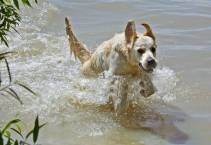 Golden Retriever Golden Retriever |
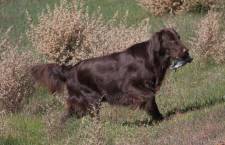 Flat Coated Retriever Flat Coated Retriever |
 Curly Coated Retreiver Curly Coated Retreiver |
|
| Body | The correct balance of body is slightly longer than Height at withers. In depth it should measure the same from withers to elbow as elbow to ground. The chest has a prominent but not exaggerated prosternum | Balanced with a level topline and long deep ribcage with moderate tuck-up. The fore ribs are fairly flat, the centre ribs more arched but they become rather lighter towards the hindquarters. Deep chest with brisket well-defined | Slightly longer than height at withers with well spring ribs and deep brisket. As the Curly is an upstanding dog, it is important that the ribs reach the elbows but does not extend beneath them |
| Front | The Golden has a good lay of shoulder with the shoulder blade and humerus being of equal length. This places the elbows well under the body. The forelegs should be straight with good bone and only a slight slope of pastern | The shoulders are obliquely set, the and the forelegs perfectly straight with good quality bone and flexible pasterns | The Curly has well laid shoulders and shoulder blade and humerus of equal length. The legs are straight with round bone and strong, flexible pasterns |
| Feet | Round and cat-like | Round and strong with well arched toes | Round and tight with well arched toes with some webbing in between them |
| Hindquarters | Strong and muscular with a good turn of stifle and short straight hocks neither turned in nor out | Muscular with moderate turn of stifle and straight hocks so he dog stands true | Powerful muscular hindquarters with moderate turn of stifle to give the dog overall balance |
| Tail | Set on and carried level with the back, strong and covered with thick coat, it should be straight and never curled or hooked | Set straight off topline, the tail itself should be short and straight | Flows from a slightly sloping croup, thick at the root and tapers to a point and is completely covered with short curls |
 Golden Retriever Golden Retriever |
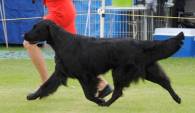 Flat Coated Retriever Flat Coated Retriever |
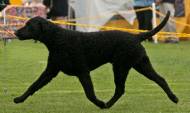 Curly Coated Retriever Curly Coated Retriever |
|
| Gait | Powerful with long and true stride | Free, flowing and true front and back | Effortless, powerful gait with good extension |
References and Further Reading
Hot off the Press! Jane has just published a book 'Gundogs Unveiled'. Information on our sister website: www.Rangeairevision.com
[2] Joan Tudor, "The Golden Retriever" published by 'Popular Dogs' publishing Co Ltd 3 Fitzroy Square, London W1 ISBN 0 09 129360
[5] " The History of Purebred Dogs in Australia" published by OzDog Newspaper 1997
[5c] Ibid., "The Golden Retriever" by Beryl Hession Page 161
[8] W M Charlesworth, 'Golden Retrievers' Published by Williams & Norgate Ltd London 1952 Chapter 1 History Pages 13 - 19
